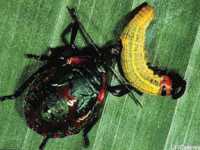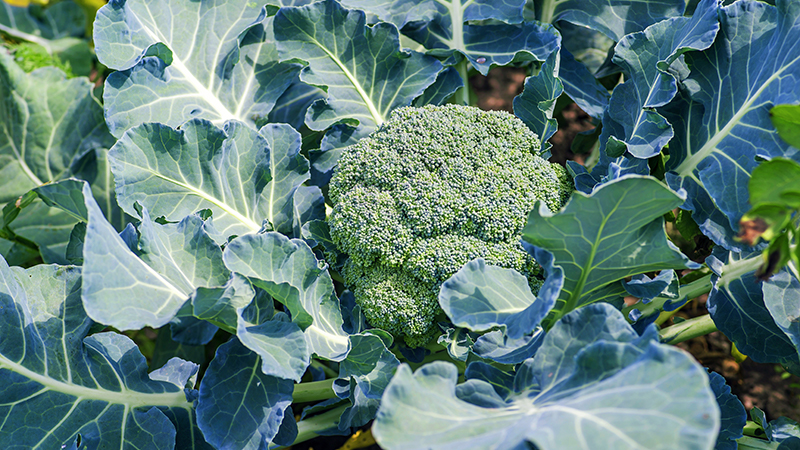Beneficial Of The Month: Predaceous Stinkbug

Identification And Reproduction
The females lay egg masses with individual eggs that are somewhat barrel-shaped and brightly colored ranging from yellow to orange. The length of time from egg to adult varies from 50 to 100 days depending on season and temperatures. Identification of the nymphs is difficult, particularly the earlier instars, which may be confused with beetles. Early instars have a blue-black head and thorax and red abdomen with dark central and lateral stripes composed of dorsal and lateral dark colored plates. Young stinkbugs lack wings and have tube-like piercing/sucking mouth parts, while beetles have chewing mouth parts and have wings or elytra forming a suture dorsally.
Adults can be distinguished from all other stinkbugs in the southeastern U.S. by a reddish spot at each corner of the scutellum outlined against a blue-black to purplish brown ground color. In addition to its bright coloration, the spines on the thorax (“shoulders”) are a common characteristic of many of the beneficial stinkbugs. Stinkbugs, which feed on plants, typically have rounded shoulders and long, thin mouthparts in contrast to the stout short beaks of the beneficial species.
Stinkbugs are known for the disagreeable odor they produce when handled.
Beneficial Activity
Nymphs and adults are gregarious, and early instars, in particular, may feed as a group. This behavior provides a selective advantage because it allows feeding on large prey unavailable to a single nymph.
E. floridanus has been collected during all months of the year in the Sunshine State. There is a peak in the spring and again in the fall. Because the prey is highly variable, predacious stinkbugs can be collected in a wide variety of habitats including citrus groves, row crops, vegetable fields, ornamental plantings, and on a variety of fruit trees.
E. floridanus has been collected during all months of the year in the Sunshine State. There is a peak in the spring and again in the fall. Because the prey is highly variable, predacious stinkbugs can be collected in a wide variety of habitats including citrus groves, row crops, vegetable fields, ornamental plantings, and on a variety of fruit trees.
Predatory stinkbugs seldom play more than a minor role in the natural control of insects in Florida. However, they are one of the few predaceous insects big and brawny enough to take on large prey. Its prey includes such economic species as southern green stinkbug, a variety of caterpillars including armyworms, orangedog, and velvetbean caterpillar, as well as Colorado potato beetles, diaprepes root weevil, and others.
Grower Options
As with beneficial insects, stinkbugs are susceptible to broad-spectrum pesticides, so growers should scout crops to verify their presence and avoid the use of such products to preserve beneficial populations. Populations also can be encouraged by creating or preserving refugia along field margins and windbreaks, which can provide a food source in lean times.
0
1
5
Beneficial Of The Month: Predaceous Stinkbug









